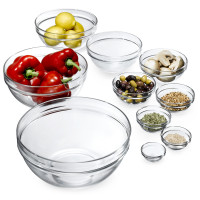What on earth is mise en place? It translates from French into “everything in its place” and is really just about prepping everything you will need during the cooking process, putting each ingredient (or sets of those things that will be cooked together) into separate and easy to access bowls or containers.
For example, many chinese dishes have you cook a variety of ingredients, adding them at different times since they require different cooking times, so it is handy to have those ingredients prepared and ready to go as they’re needed. Let’s say that the dish requires carrots, red peppers, onions, scallions, water chestnuts, chicken, cashews and a sauce (a combo of cornstarch, soy sauce, mirin, rice vinegar, sugar and water).
Mise en place for this dish means you should julienne the carrots and place them in a bowl. Chop the red peppers into the desired shape/size, and place in a separate bowl. Chop the onions, and place in their own bowl. And do the same for the scallions, water chestnuts, chicken and cashews. For the sauce, mix all the sauce ingredients together in one bowl or measuring cup. When you’re ready to cook, put all the bowls of ingredients near the stove or wok and simply add as the timing calls for. No need to prep in between cooking, everything is easy to see, etc.
This technique is particularly useful for a dish like above that requires relatively quick additions in succession where you won’t have time to prep the ingredients in between each step. It’s also perfect for advance preparation for a dinner party so you can do the quick cooking a la minute without having to spend time away from your guests while prepping. Very worthy of noting at this point is that prep is not only for uncooked ingredients. You may also want to par-boil veggies beforehand and then stop the cooking in ice water, making them ready for final cooking when ready. Similarly, you can toast nuts, sear meat, pre-cook noodles, make a sauce or any other early stage cooking that will help speed the final cooking and assembly process. Be careful, however, to do this only when a wait between prep and cook time won’t negatively affect the dish. Some sauces, for example, will separate if left unattended and recombining is not always flawless.
It might sound like this technique requires an awful lot of bowls! Truthfully, I find I use somewhere between 2-6 on average, unless it’s a menu with an unusually large number of ingredients. I keep a bunch of glass bowls in various sizes for just this purpose, and they nest/stack nicely to save room. Sur La Table sells all sizes of glass prep bowls, and here’s a handy link for more info: Stackable Prep Bowls.
I find that I never cook a meal without doing mise en place…I think once you try it once or twice, you’ll find that the ease and convenience makes it an irresistable technique.
Bon appetit!




0 Comments